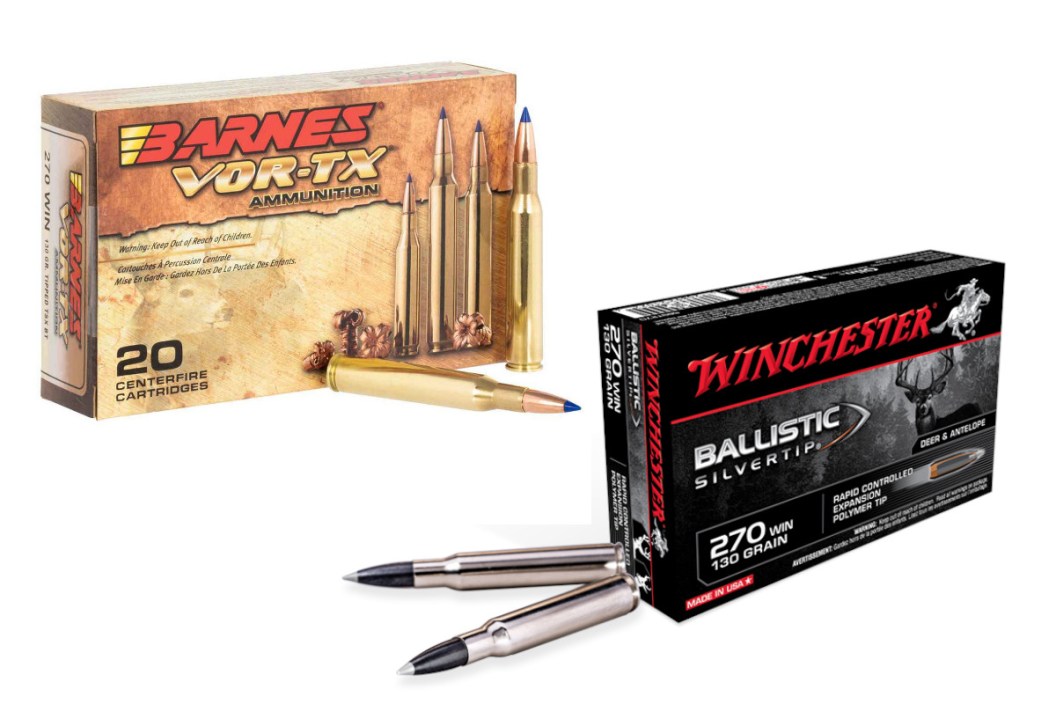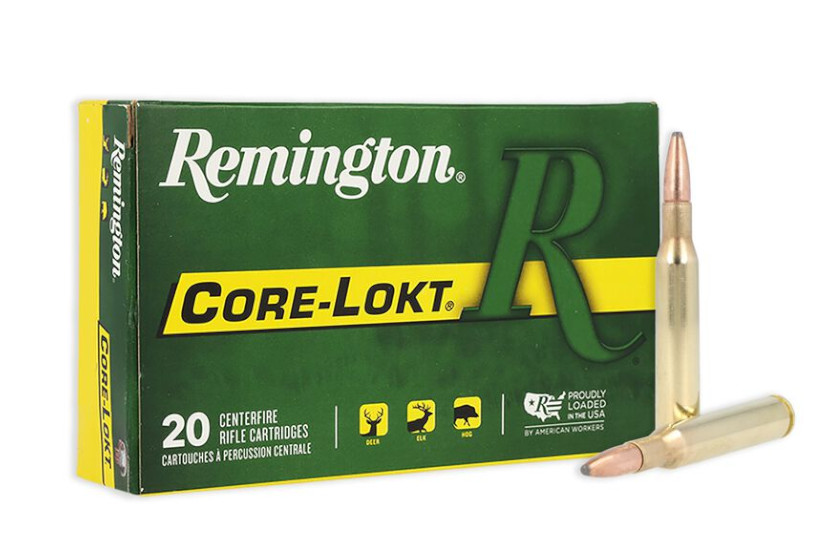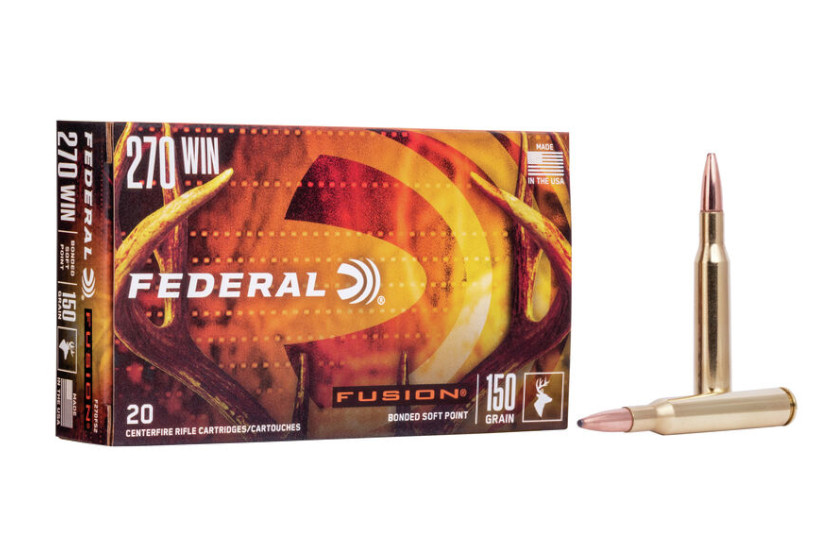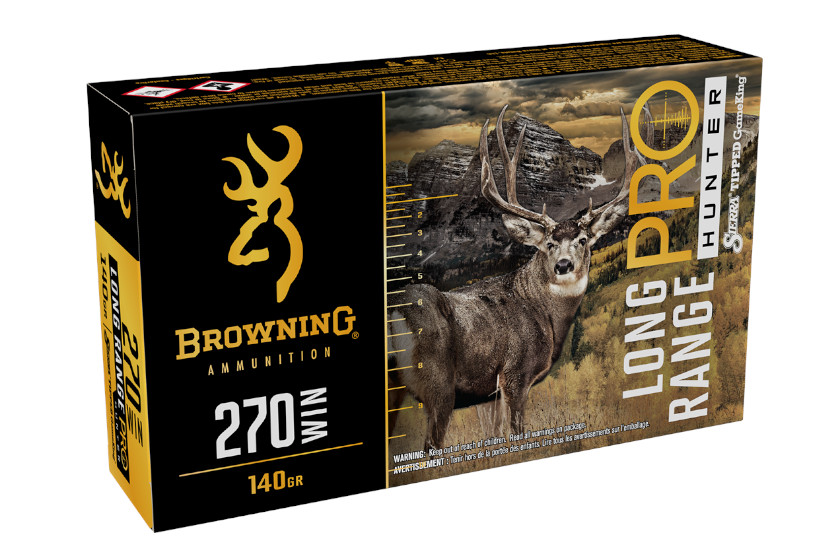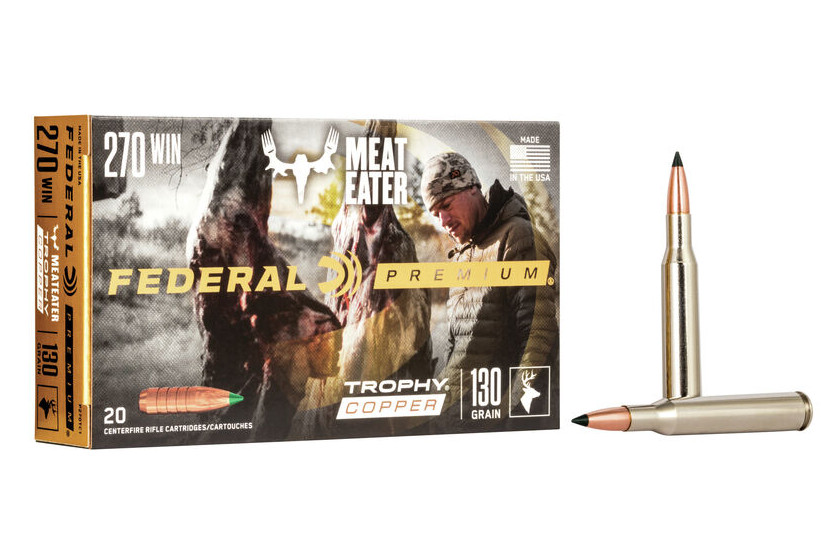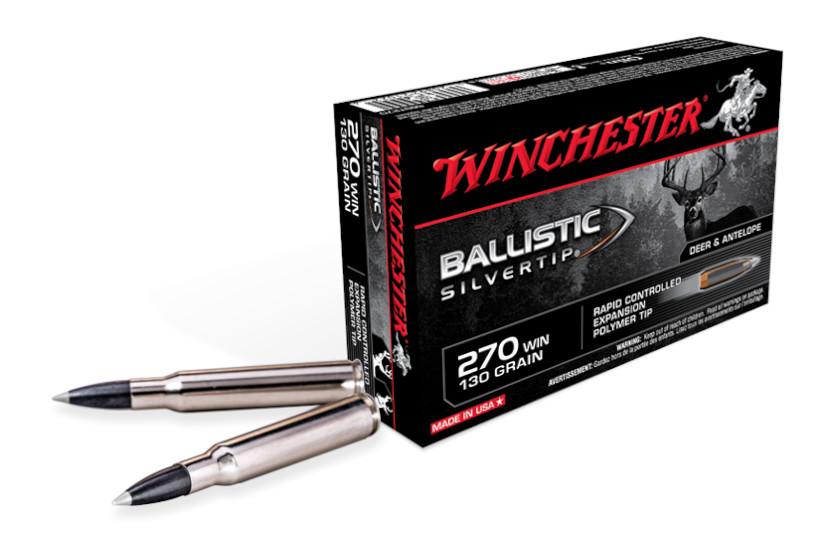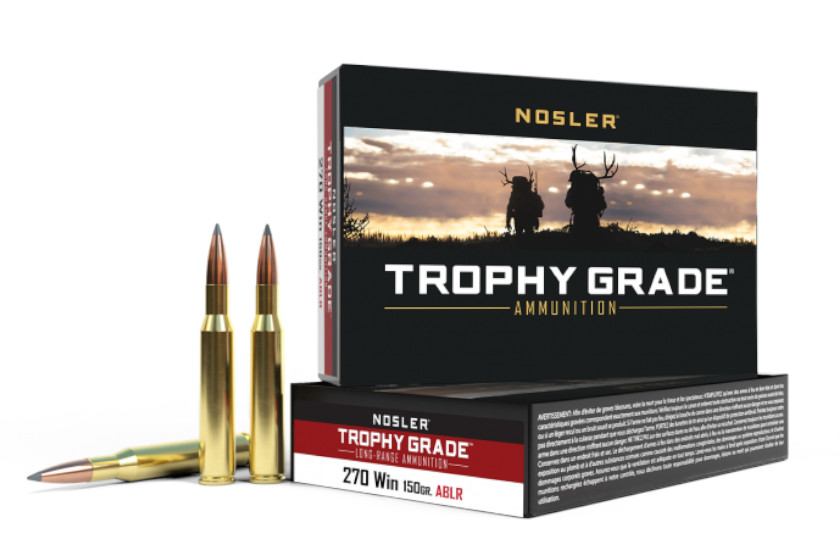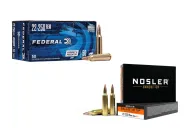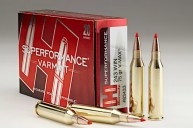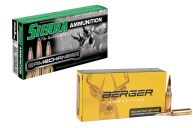Since its introduction in 1923, the iconic .270 Winchester has gained legions of fans among big-game hunters all over the world. It's a fast, efficient round with plenty of knock-down power for medium-sized big-game animals like whitetails and mule deer. At the same time, it also carries enough energy for bear, elk, and even moose—with proper placement. Legendary outdoor writer Jack O'Connor was the round's biggest fan and helped popularize its use among hunters today.
While it does feel like the .270 win has fallen off in popularity in the face of newer, faster rounds like the 6.5 Creedmoor, it's still a great choice for the hunter who wants something simple that's going to get the job done every time. We've talked about our favorite .270 Winchester rifles in the past. Today, we're going to go a little more in-depth on the round itself, and we'll give you our top picks for factory .270 Winchester ammo options that are still being made today.
Specs and Ballistics of the .270 Winchester

Media News Group Daily Local News via Getty Images
The .270's history can be tied to its parent case, the now defunct .30-03, which only lasted eight years, and was originally developed for the Springfield M1903 bolt-action service rifle. In any case, the modified .270 Winchester has a 2.540-inch case length and uses a .277-inch diameter bullet. The overall length of the centerfire cartridge is about 3.340 inches. The case capacity is about 67 grams. Most hunters use bullet weights varying from 130 to 150 grains.
As far as muzzle velocity goes, the .270 Winchester gets up over 3,000 fps when using lighter 130-grain bullets. Even when you up that to 140 or 150 grains, most factory rounds still have a muzzle velocity of at least 2,800 fps. And the rounds carry that speed extremely well. In most cases, the rounds don't dip beneath 2,000 fps until they hit the 500-yard mark.
The .270 also does a great job distributing its energy. This round is usually delivering anywhere from 2,600 to 2,700 foot-pounds of energy at the muzzle. Most factory rifle ammo carries anywhere from 1,100 to 1,300 foot-pounds of energy out to distances of 500 yards, which is under the 1,400 foot-pounds of energy usually recommended to kill an elk, but it's more than enough for deer and other medium-sized game like pronghorn antelope. The .270 can be very effective on elk out to 300 yards.
As far as range goes, most .270 Win ammo remains very flat out to 200 yards. Most factory ammo has a zero of 100 or 200 yards. Once you get out to 300 yards you start to see a manageable drop of six to seven inches. It's only once the .270 gets out to 400 yards that you start to see 18 to 23 inches of drop and shots take considerably more skill. Most manufacturers put their 500-yard trajectory at -35 to -40 inches. Most hunters are probably going to find the .270 most comfortable at ranges of 150 to 250 yards at the most. Although this is an excellent option for anyone who wants to reach at least 300. Now that you have an idea of what this round can do, let's look at some of the best factory hunting rounds to fit a variety of budgets and scenarios. We'll work our way down from some of the more affordable .270 Win ammo options to the more expensive ones.
Remington Core-Lokt
Starting off on the more affordable scale, Core-Lokt is a solid choice for range shooting, or for hunters who simply don't want to spend a small fortune on expensive rifle ammo. These are available for about $33 a box. And Remington ships these rounds practically everywhere, making it one of the more accessible options out there during shortages. These rounds utilize a simple pointed soft point (PSP) bullet that has a lead core and copper jacket. The 150-grain version is doing 2,910 fps at the muzzle and has a muzzle energy of 2,820 foot-pounds. The 130-grain version is obviously a little faster, doing 3,060 fps of muzzle velocity and hitting with 2,703 foot-pounds of energy. These rounds are great from an affordability and accessibility standpoint. The one downside is the ballistic coefficients of .261 for the 150-grain and .336 for the 130-grain bullet weights aren't very high, so they're not quite as aerodynamic as some other options on the market.
Federal Fusion
A slight step up from the Core-Lokt, but still affordable, is the Federal Fusion. It has a higher ballistic coefficient of .471 which is going to help these bonded core soft points cut through the air much better. Federal Premium engineered this round specifically for deer, but there's no reason it won't be effective on other medium game like pronghorn antelope or wild hogs. The bullets have a skivied tip helping them expand upon impact. Federal also molecularly fused the jacket to the core. This helps with weight retention and keeps the core and jacket together for better penetration. The ballistics are there, too. The 130-grain version is doing 3,050 fps from the muzzle and hits with 2,685 foot-pounds of energy, enough to drop most deer in their tracks. The 150-grain version is slightly slower at 2,850 foot-pounds, but packs a bigger, 2,705 foot-pounds of muzzle energy punch. At about $40 a box, these rounds are still highly affordable for most budgets.
Winchester Super-X Power-Point
We really like the availability of these rounds and how they group at ranges of 100 to 200 yards, which is ideal for most deer hunting scenarios. The bullets of these rounds feature an alloyed lead core with a contoured jacket. They pack a nice punch, with Winchester producing a 130-grain version that produces muzzle energies of 2,702 foot-pounds, and a 150-grain version that's packing 2,705 foot-pounds of energy. As for velocity, you're looking at 2,850 fps from the 150-grain bullet weight and 3,060 fps from the 130-grain version. These aren't the tightest grouping rounds we've ever used, nor do we think they're best for long-range past 200 yards. However, for most average hunters, Super-X is available at literally almost every place that sells ammunition in America. Plus, it's usually only about $33 a box, sometimes less if you catch a sale. This makes it a more affordable factory option for extended-range sessions.
Hornady American Whitetail
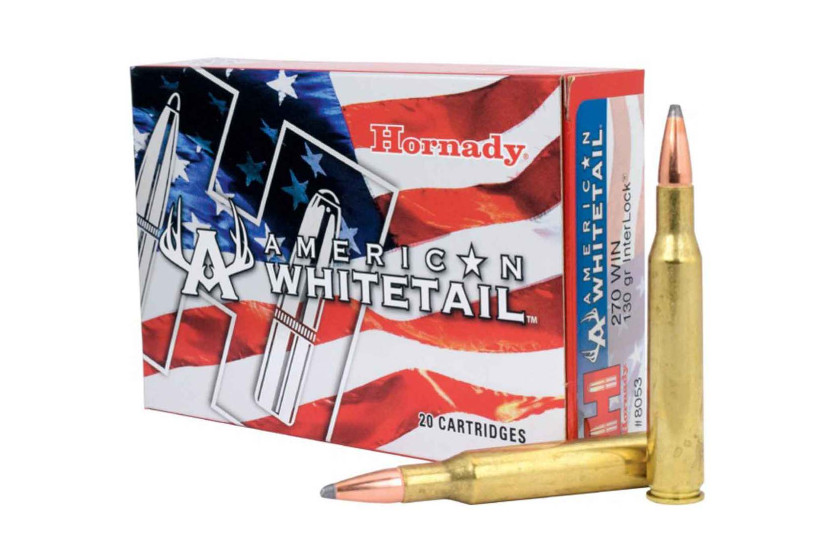
Sportsman's Warehouse
These rounds have quickly become a staple for hunters across the country thanks to their affordability and knockdown power. Hornady gives these jacketed soft points their signature InterLock ring outside the jacket. It is embedded into the lead core and helps keep the two components together upon expansion. Hornady makes a 140-grain option that's doing 2,940 fps at the muzzle and hitting with 2,687 foot-pounds of energy. This option has zero drop at 200 yards and only -6.9 at 300. It also has a higher ballistic coefficient of .486, which will help it cut through the wind quite nicely. The 130-grain soft points have a .409 ballistic coefficient and zero drop at 200 yards, -6.4 at 300. The 130-grain rounds are doing 3,060 fps at the muzzle and hit with 2,703 foot-pounds of energy. For the ballistics this one provides, the American Whitetail rounds are a deal at around $33 a box. Like the other options, they're also readily available from most sporting goods retailers across the country. These were some of the first rounds we saw back in stock as the ammo shortages have finally started to ease up.
Sig Sauer Elite Hunter Tipped
Stepping things up to a slightly higher-quality ammo that goes for about $45 a box is the Sig Sauer Elite Hunter tipped. These rounds feature a 140-grain bullet with a ballistic tip. Because this is a boat tail bullet design, it has a high-ballistic coefficient of 0.508. Ideal for those windier western states like Wyoming where it becomes a factor at longer ranges. Sig Sauer gave these rounds nickel-plated cases which added an anti-corrosion element, allowing this rifle ammunition to cycle a little easier from most modern hunting rifles. These rounds use 140-grain bullets that are doing 2,950 fps at the muzzle and are putting out 2,705 foot-pounds of energy to the target. These are an excellent option for anyone planning to hunt the open spaces of the western U.S. without totally breaking the bank on ammo costs.
Browning Long Range Pro Hunter
We like this option for anyone who's looking to push a .270 Winchester 140-grain bullet out to 300 yards and beyond without paying $60+ a box for the performance. Browning fits these bullets with Sierra Tipped Game King bullets. Once again, these are boat tail bullets with a ballistic tip that's going to help stabilize these extremely well in flight. These rounds have a muzzle velocity of 2,970 fps and a muzzle energy of 2,742 fps. The long-range trajectory of these is great. Browning puts the drop at zero for 200 yards and only -6.6 for 300. The 400-yard trajectory is -19.1 and the 500-yard trajectory is -38.4. At 500 yards, these rounds are still doing 2,100 fps and are hitting with 1,383 foot-pounds of energy, which means you could potentially harvest an elk at that range with one of these effectively. These start at about $48 a box, which isn't cheap, but they're a solid option for those hunts where you want something with a little more accuracy at range than soft point .270 Winchester ammunition.
Federal Premium Trophy Copper
More states than ever are adopting lead-free requirements for hunters wishing to use them. In the past, many hunters scoffed at the idea of using copper, but the technology has improved greatly in recent years. Federal Premium's Trophy Copper uses a boat tail bullet with a polymer tip that gives it a decent ballistic coefficient of .459. Additionally, Federal Premium grooved the bullet shank to help increase the accuracy of these 130-grain rounds. They've got a decent amount of speed too. Expect 3,060 fps from the muzzle and 2,703 foot-pounds of energy. It's comparable to many lead-core designs of the same bullet weight. These are flat shooting rounds too. They have a 200-yard zero and only -6.3 inches of drop at 300 yards. They're still doing 2,459 fps at that distance and they're hitting with 1,745 foot-pounds of energy. Steven Rinella uses these rounds all the time while filming his show MeatEater, and they've proven themselves in the field. At $56 a box, they're expensive but still come in slightly cheaper than many higher-end lead core options on the market.
Barnes VOR-TX
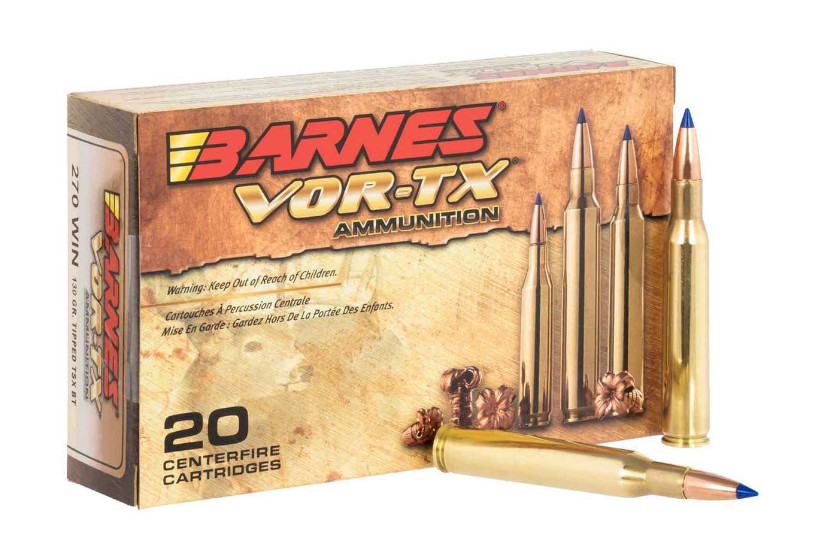
Sportsman's Warehouse
Another all-copper, non-toxic option that's going to be ideal for public lands with lead bans is Barnes VOR-TX. These rounds are loaded with Barnes Triple-Shock X tipped bullets. There's a polymer tip that helps the nose cavity promote some nice expansion upon impact without fragmenting. Barnes TSX is a boat tail design with three grooved rings that help reduce the chances of copper fouling. These rounds have a ballistic coefficient of 0.392 and a ton of speed behind them. The 130-grain Barnes is doing a whopping 3,140 fps at the muzzle from a 24-inch test barrel. The muzzle energy is a hefty 2,847 foot-pounds. It carries this energy nicely, as you're still 1,422 foot-pounds at 400 yards. Speaking of long-range, Barnes' data puts zero drop at 200 yards and only -6.3 at 300 yards. The 400-yard drop is -18.5 and the 500-yard drop is -37.7 inches. These are the factory rounds we'd recommend to someone on public land who's anticipating shots to at least 300 yards. These go for about $55 a box, which isn't too bad price-wise for the quality of bullets Barnes loads these with.
Winchester Ballistic Silvertip
These Winchester 130-grain rounds are an ideal choice for the hunter who has a special deer or antelope hunt upcoming and who doesn't want to leave much to chance. These polymer tip boat tail bullets feature an alloyed lead core with a contoured jacket. One big additional feature is a black-oxide coating that reduces fouling in the barrel. These rounds are extremely accurate and produce consistent, tight groups for anyone seeking precision. The muzzle velocity on the Silvertips is 3,050 fps, and the muzzle energy is 2,685 foot-pounds. The long-range trajectory is great too. These rounds have zero drop at 200 yards and only about -6.5 at 300. Winchester doesn't have 500-yard energy data, but these rounds are still doing 2,040 fps at 500 yards making these an excellent option for anyone anticipating longer shots. It's just a great bullet design that expands quite efficiently and gives a lot of knockdown power for anyone who doesn't like tracking. These can usually be found for around $50 a box, which isn't that bad for the quality of the bullets and casing.
Hornady Superformance
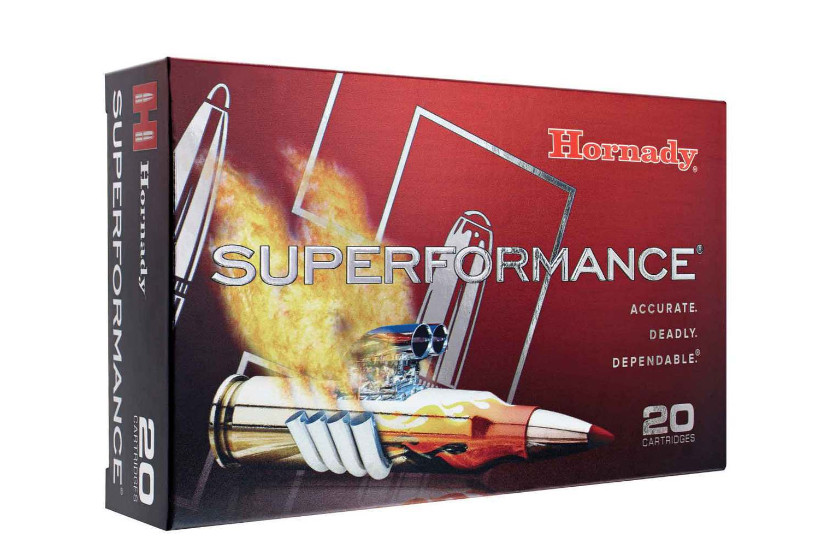
Sportsman's Warehouse
These are the rounds to buy if you want to push the .270 to its speed limits. We appreciate the fact Hornady gives us options with these .270 Winchester 130-grain rounds. There's a Super Shock Tip (SST) option with a lead core, InterLock ring, and cannelure to keep the core and jacket together. Then there's also an all-copper expanding (CX) option for hunting on public lands. It's hard to go wrong with either one of these. The SSTs are doing a blazing 3,200 fps at the muzzle while delivering 2,955 foot-pounds of energy. The CX version is doing 3,190 fps, and hits with 2,937 foot-pounds of energy. That little bit of extra speed produced by these rounds helps flatten the trajectory slightly, too. Hornady puts the drop for the CX at -6 inches at 300 yards and -5.7 inches at the same distance. The SSTs carry 2,213 fps speeds and 1,414 foot-pounds of energy out to 500 yards. The CX rounds are doing 2,085 fps at that distance and hit with 1,255 foot-pounds of energy, making either one rather capable for longer shots at big game. Expect to pay about $45 a box for the SST version and about $50 a box for the copper, which isn't bad at all considering the type of performance you'll get from these rounds.
Federal Nosler Partition
The Nosler Partition bullet has something of a legendary reputation, and that's why it's found its way into so many cartridges over the years. It's a dual-core bullet with a literal partition that separates the alloy lead core. This allows the bullet to retain more weight and penetrate deeper upon impact. It makes this .270 Winchester 150-grain round an ideal option for larger game like elk. These rounds have a good ballistic coefficient of .466. They are doing about 2,830 fps at the muzzle and dish-out about 2,667 foot-pounds of muzzle energy. These rounds have some excellent knockdown power, but you might want to keep shots within a 400-yard window. Simply because the 400-yard energy is 1,459 foot-pounds and the 500-yard energy drops down to 1,238 foot-pounds, which is just under what many experts recommend for energy to kill an elk. It could still be effectively used on elk at that distance. These start at about $60 a box, so they aren't cheap, but you're paying mostly for the quality of the bullets here.
Nosler Trophy Grade Long Range
While most average hunters probably aren't going to push things to that 500-yard mark, Nosler AccuBond is the ammo to consider if you're going to try. These rounds feature a boat tail bullet design where the jacket and core are bonded. When Nosler designed these rounds, they were specifically making sure hunters were still getting decent expansion at reduced velocities most bullets experience at extreme range. Thus, these rounds are doing 2,850 fps at the muzzle with 2,705 foot-pounds of energy. However, these rounds carry an amazing amount of speed, 1,979 fps to be exact, out to 600 yards. At that distance, you're getting about 1,304 foot-pounds of energy, which is about the minimum recommendation by most state wildlife agencies to kill an elk. We can't say we recommend shooting at that range since these rounds experience -77.9 inches of drop at 600 yards alone. However, if you're thinking about those extended ranges, this is probably the best factory ammo on the market for it. The catch is that it's expensive. We've seen it online going for about $78 a box.
For more outdoor content from Travis Smola, be sure to follow him on Twitter and Instagram For original videos, check out his Geocaching and Outdoors with Travis YouTube channels.
